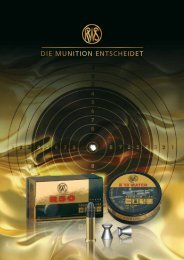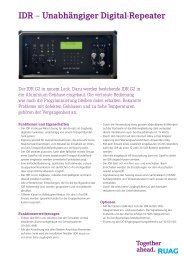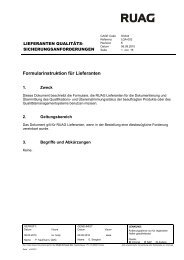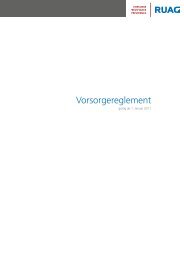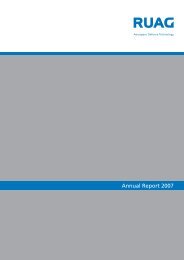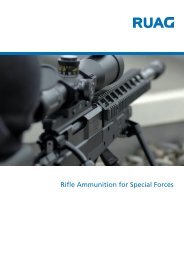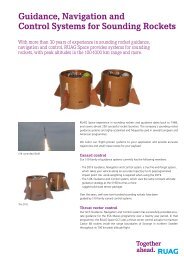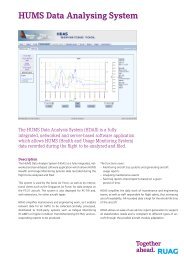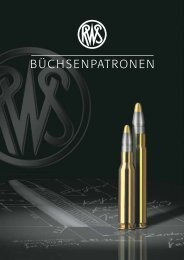Do 228NG - Benefit from a New Generation - RUAG
Do 228NG - Benefit from a New Generation - RUAG
Do 228NG - Benefit from a New Generation - RUAG
Create successful ePaper yourself
Turn your PDF publications into a flip-book with our unique Google optimized e-Paper software.
<strong>New</strong>ly developed five-bladed propellers.<br />
Best in safety and reliability<br />
The <strong>Do</strong> <strong>228NG</strong> takes to the skies with<br />
newly developed five-bladed propellers.<br />
They combine a wooden core and a surface<br />
consisting of multiple fiber composite<br />
layers. This makes them especially light, allowing<br />
a quicker start of the engines.<br />
In addition, the five narrow diameter<br />
blades make the propellers low in vibration<br />
and even quieter. Driven by two Garrett<br />
TPE 331-10 engines, they provide best hot<br />
Unique among its competitors, the <strong>Do</strong> 228 <strong>New</strong> <strong>Generation</strong> offers a high level of safety<br />
even in its standard version, with its state-of-the-art electronics and huge power reserves<br />
being just two of the key features in point. The <strong>Do</strong> <strong>228NG</strong> is also one of the most reliable<br />
aircraft in the world with its perfect mix of a mature design and innovative technologies.<br />
Safety comes first at <strong>RUAG</strong><br />
When it comes to on-board safety of passengers<br />
and crew members there is no<br />
room for compromises at <strong>RUAG</strong>. All the<br />
innovations making the <strong>Do</strong> <strong>228NG</strong> the<br />
most advanced 19-seater are directed towards<br />
achieving this goal. It goes without<br />
saying that the <strong>Do</strong> <strong>228NG</strong> meets all the<br />
legal and official requirements for operation<br />
worldwide.<br />
This aircraft type complies with the regulations<br />
of both the European Aviation<br />
Safety Agency (EASA) and the U.S. Federal<br />
Aviation Administration (FAA). That is why<br />
both the <strong>Do</strong> <strong>228NG</strong> and its predecessors<br />
meet the strict safety regulations of the<br />
FAA‘s FAR part 23 standard. What is more,<br />
the optional safety equipment available in<br />
the <strong>Do</strong> <strong>228NG</strong> is comparable with that of<br />
much larger passenger aircraft.<br />
Propellers and engines<br />
Safety Equipment (sample)<br />
Engine Indicating and Crew Alerting<br />
System (EICAS)<br />
Autopilot (Option)<br />
Airborne Collision Avoidance System<br />
(ACAS) (Option)<br />
Terrain Awareness System (TAWS)<br />
(Option)<br />
and high performance in its class. They are<br />
flat-rated to 776 of their potential 1,000<br />
shaft horsepower, leaving them with crucial<br />
power reserves for high-temperature<br />
or high-altitude regimes.<br />
Thanks to the advanced technology of its<br />
engines, the <strong>Do</strong> <strong>228NG</strong> has the longest<br />
time between overhaul (TBO) of all 19 seat<br />
aircraft – up to 7,000 hours.<br />
More than 99% dispatch reliability<br />
Operators can rely on the <strong>Do</strong> <strong>228NG</strong> at all<br />
times. The aircraft has a dispatch reliability<br />
of over 99%, a peak value that goes<br />
hand in hand with low maintenance costs.<br />
Consequently, operators of this aircraft<br />
can concentrate on their core activities because<br />
the <strong>Do</strong> <strong>228NG</strong> is always ready to fly<br />
when needed. This high degree of reliability<br />
is unmatched in this aircraft class.<br />
5



